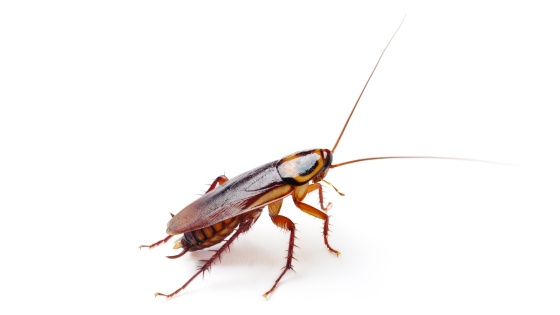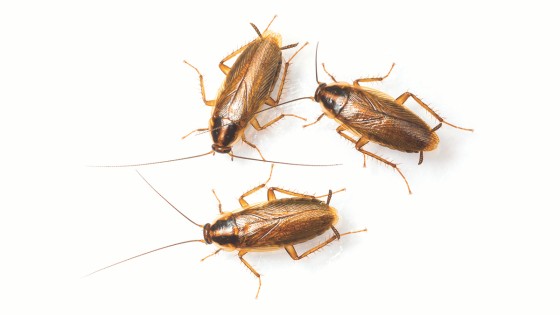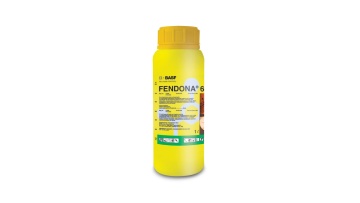Cockroaches
Cockroaches present one of the most significant public health risks, carrying diseases such as dysentery, gastroenteritis, diarrhoea, typhoid, poliomyelitis and salmonella.

They are most commonly found in commercial premises in which food is produced or handled, such as restaurants and catering establishments. However, they are not uncommon in domestic situations where they live in kitchens and drains.
Cockroaches are nocturnal creatures, which spend the daytime hours hiding in cracks and crevices around sources of food and water such as cookers and sinks.
Complex pipework systems and underground ducts in larger buildings can make their control all the more difficult. Food contamination occurs when the cockroach moves from refuse to food preparation areas.
Cockroaches will eat practically anything from human food to leather, wallpaper and even other cockroaches.
Types of cockroaches
A description of some common cockroaches
German cockroach
Latin name: | Blatella germanica |
Length: | 12 - 15 mm at adult stage. |
Colour & description: | Yellowish, brown with two longitudinal black streaks on pronotum. Winged but do not normally fly. |
Habits & habitat: | Primarily nocturnal. Prefer warm & humid conditions. Prefer narrow harbourages close to food & water. Can climb smooth surfaces. Female carries the ootheca attached to her abdomen until the nymphs are about to hatch. |
Life cycle: | 100 - 200 days. Reproduction rate: Females produce 4-8 egg cases (ootheca) over lifetime. Each case with 30 - 40 eggs. |
Brown banded cockroach
Latin name: | Supella Longipalpa |
Length: | 10 - 15 mm at adult stag |
Colour & description: | Reddish/brown with yellow halo around pronotum edge.Have 2 light yellow/brown bands across body. Are flattened with prickly legs and long antennae. Adult male can fly. |
Habits & habitat: | Similar to the German cockroach. Prefer warm & humid conditions and narrow harbourages. Females glue egg cases in furniture & cupboards |
Life cycle: | 160 days. Reproduction rate: Females produce 10-14 egg cases (ootheca) over lifetime. Each case with 10-18 eggs. |
Oriental Cockroach
Latin name: | Blatta Orientalis |
Length: | 17 - 30 mm at adult stage |
Colour & description: | Very dark, almost black in colour. Have wings that do not cover the abdomen, do not fly. |
Habits & habitat: | Fond of dark, hidden, damp cool places such as cellars/basements. Therefore, some harbourages maybe outside of the treatment area making control difficult. Mainly active in the night & at dawn. Are cold weather tolerant. |
Life cycle: | Up to 500 days |
American Cockroach
Latin name: | Periplaneta Americana |
Length: | 25 - 40 mm at adult stage |
Colour & description: | Reddish wings completely cover abdomen. Yellow band around pronotum edge. Are able to fly. |
Habits & habitat: | Prefers dark, hidden, hot and humid places. Often present where food is stored & prepared. Some harbourages maybe outside of the treatment area making control more difficult. |
Life cycle: | 450 days. Reproduction rate: Females produce 9 – 10 egg cases over lifetime. Each containing 12–16 egg |

Crack & Crevice Treatment
Even well managed gel baiting may need to be supported by complementary crack and crevice treatment. The effectiveness of lower potency insecticide baits tends to be restricted by a less effective ‘cascade effect’ as well as any restriction on uptake.
Equally, full control can only be achieved both once all eggs have hatched and nymphs have either matured to the foraging stage or, have consumed sufficient insecticide from eating poisoned individuals or their feces.
These difficulties are best overcome by the targeted treatment of key harborages with a complementary residual insecticide spray like Mythic SC.
Fendona® should be the first choice for crack and crevice cockroach treatment, and we can use Mythic SC to improve the speed of control alongside targeted baiting or as the main prescription in areas where baiting is likely to be less effective.



